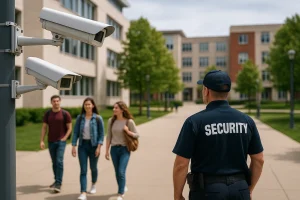How to Prepare Your Office for an Active Shooter Situation: A Comprehensive Guide
H ow to Prepare Your Office for an Active Shooter Situation: A Comprehensive Guide The risk of an active shooter in the workplace, though statistically rare, is a concern that employers and employees should be prepared for. By developing a proactive approach and training for potential emergencies, the effects of such a devastating event can […]
By David Kerolles
August 22, 2023
H ow to Prepare Your Office for an Active Shooter Situation: A Comprehensive Guide
The risk of an active shooter in the workplace, though statistically rare, is a concern that employers and employees should be prepared for. By developing a proactive approach and training for potential emergencies, the effects of such a devastating event can be mitigated. This guide addresses how to prepare various office spaces and offers safety tips for an active shooter situation.
1. Understanding the Basics:
- Active Shooter: An individual actively engaged in killing or attempting to kill people in a confined and populated area.
- Preparation: Preparation doesn’t mean expecting the worst every day but being prepared for it just in case.
2. Risk Assessment and Planning:
- Consultation: Consider hiring a security consultant who can provide expert guidance tailored to your facility’s specific needs.
- Analyze entry and exit points: Limit the number of entry points into your building while ensuring that exit routes are numerous and clearly marked.
- Establish a notification system: Use an intercom, PA system, or mass notification software to alert employees quickly.
3. Safety Tips:
-
Run, Hide, Fight: This is the universally recognized response protocol for active shooter situations:
- Run: Escape if the path is clear. Encourage employees to know all exit points.
- Hide: If escape isn’t an option, find a place to hide. Lock doors, turn off lights, and silence phones.
- Fight: As a last resort, and only if your life is in immediate danger, attempt to incapacitate the shooter.
-
Pre-identify safe spaces: Each employee should know at least two places where they can hide in an emergency.
-
Stay quiet and calm: If hiding, silence phones and keep quiet. Calm breathing can make a difference.
-
Always be observant: Recognize the sound of gunshots. React quickly and decisively.
4. Preparing Different Office Types:
-
Open Office Spaces:
- Barrier creation: Use desks, cubicles, and partitions to create hiding spaces. Large equipment or art installations can also be utilized.
- Visual shields: Use blinds or curtains on windows to obstruct a shooter’s view.
-
Traditional Offices:
- Sturdy doors: Ensure doors are robust and can be locked. Consider adding a secondary locking mechanism.
- Safe corners: Identify areas in each office out of the line of sight from the door where an individual can hide.
-
Multi-Floor Offices:
- Stairwell safety: Ensure stairwells are accessible, well-lit, and can be used for quick evacuation.
- Elevator strategy: Generally, avoid using elevators during an active shooter situation. The shooter can intercept them or they can become inoperable.
-
Shared Office Spaces:
- Unified protocol: Collaborate with other companies or tenants to create a cohesive emergency response plan.
- Regular drills: Practice with all entities to ensure everyone knows the plan.
5. Training and Drills:
- Regular drills: Hold active shooter drills regularly, ensuring that new employees are trained and current employees remember the protocol.
- Expert-led sessions: Consider bringing in local law enforcement or security consultants to guide training sessions.
- Feedback: After drills, gather feedback and look for areas of improvement.
6. Post-Incident Response:
- Immediate lockdown: Ensure the safety of all employees first.
- Communication: Notify authorities immediately. Relay information clearly and calmly.
- Trauma counseling: Recognize that post-incident, employees might need counseling or support.
7. Continuous Improvement:
- Update and review: Continuously update your emergency response plans as your company grows or changes.
- Engage with experts: Periodically consult with security experts to stay abreast of best practices.
Conclusion:
The thought of an active shooter in the workplace is unsettling. However, with proactive planning, regular training, and by fostering a culture of safety and awareness, employers can equip their staff with the knowledge to respond effectively should the unthinkable occur. Remember, preparation is not about living in fear but about being empowered to protect oneself and others.
Related Posts
Safest Places to Live in the US
Never before have there been so many options in your search for a safe neighborhood residence. In the Northeastern area of the United States, for instance, Nassau or Rockland counties contain some of the safest neighborhoods in New York State. In the South Central region, many have discovered the safest neighborhoods in Texas to be […]
By Catherine Shannon
October 10, 2024
Safety
Security guards are vigilant guardians whose role in safeguarding people and assets can best be accomplished by the most efficient security guard tools. Security guard safety equipment is often referred to as personal protective equipment (or PPE), and it protects security guards from hazards,potential confrontations, and aids them in their duties. Here is an alphabetical […]
By David Kerolles
May 7, 2024
Regulations
Security has always been a paramount concern for civilizations, be it in the form of fortified castles in the Middle Ages or surveillance cameras in today’s digital age. The methods and means have evolved, and nowhere is this evolution more evident than in security patrol services. In the modern era, as threats become more multifaceted […]
By David Kerolles
August 27, 2023





